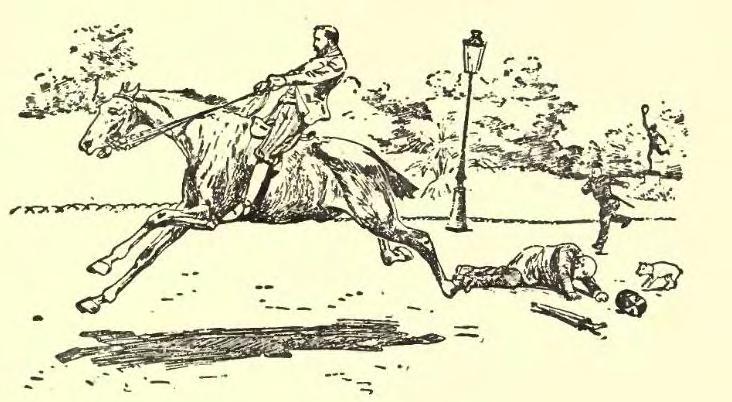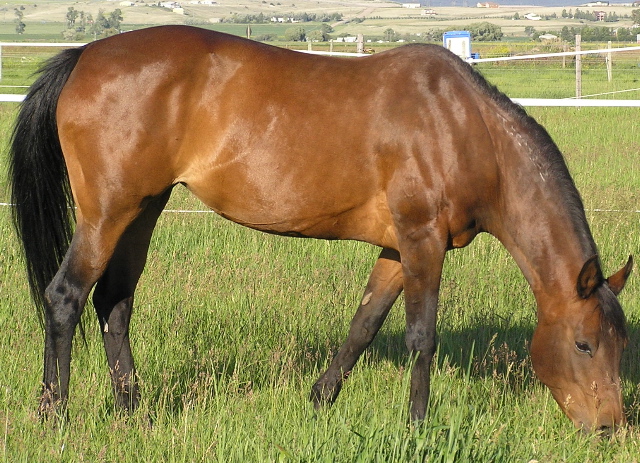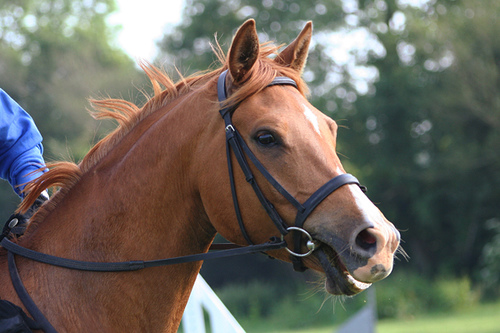|
Bolting (horse)
Bolting, when referring to equids, generally refers to two equine behaviors, both undesirable: * Running away without control. * Eating food at a dangerously fast rate. However, there are other meanings as well. For example, in Australia a ''bolter'' is a racehorse that wins at long betting odds. Runaways Most often, bolting refers to a "runaway" - horses that gallop off with a handler at high speed, whether being ridden under saddle or driving in harness. There are many causes, most linked to fright that triggers the fight-or-flight response of the horse. In these circumstances, the horse is often running in a panic and may not notice where it is going, creating danger for both horse and rider. Less often, bolting is a deliberate disobedience by a horse that wishes to rid itself of a handler or avoid an unpleasant situation. In both cases, bolting horses are usually stopped by being turned in some type of circle by pulling on one rein to turn the head to the side, as directly pu ... [...More Info...] [...Related Items...] OR: [Wikipedia] [Google] [Baidu] |
Equid
Equidae (sometimes known as the horse family) is the taxonomic family of horses and related animals, including the extant horses, asses, and zebras, and many other species known only from fossils. All extant species are in the genus '' Equus'', which originated in North America. Equidae belongs to the order Perissodactyla, which includes the extant tapirs and rhinoceros, and several extinct families. The term equid refers to any member of this family, including any equine. Evolution The oldest known fossils assigned to Equidae were found in North America, and date from the early Eocene epoch, 54 million years ago. They were once assigned to the genus ''Hyracotherium'', but the type species of that genus is now regarded as a palaeothere. The other species have been split off into different genera. These early equids were fox-sized animals with three toes on the hind feet, and four on the front feet. They were herbivorous browsers on relatively soft plants, and already adapted ... [...More Info...] [...Related Items...] OR: [Wikipedia] [Google] [Baidu] |
Pasture
Pasture (from the Latin ''pastus'', past participle of ''pascere'', "to feed") is land used for grazing. Pasture lands in the narrow sense are enclosed tracts of farmland, grazed by domesticated livestock, such as horses, cattle, sheep, or swine. The vegetation of tended pasture, forage, consists mainly of grasses, with an interspersion of legumes and other forbs (non-grass herbaceous plants). Pasture is typically grazed throughout the summer, in contrast to meadow which is ungrazed or used for grazing only after being mown to make hay for animal fodder. Pasture in a wider sense additionally includes rangelands, other unenclosed pastoral systems, and land types used by wild animals for grazing or browsing. Pasture lands in the narrow sense are distinguished from rangelands by being managed through more intensive agricultural practices of seeding, irrigation, and the use of fertilizers, while rangelands grow primarily native vegetation, managed with extensive practices like co ... [...More Info...] [...Related Items...] OR: [Wikipedia] [Google] [Baidu] |
Stable Vices
Stable vices are stereotypies of equines, especially horses. They are usually undesirable habits that often develop as a result of being confined in a stable with boredom, hunger, isolation, excess energy, or insufficient exercise. They present a management issue, not only leading to facility damage from chewing, kicking, and repetitive motion, but also leading to health consequences for the animal if not addressed. They also raise animal welfare concerns. Stereotypical behaviors in animals are generally thought to be caused by artificial environments that do not allow animals to satisfy their normal behavioral needs. Rather than refer to these behaviors as abnormal, it has been suggested that they be described as "behavior indicative of an abnormal environment". It was once thought that stable vices may be learned by observing other horses already performing the behaviors, but studies on the topic to date have failed to establish this as a cause. Stereotypies are correlated ... [...More Info...] [...Related Items...] OR: [Wikipedia] [Google] [Baidu] |
Riding Aids
Riding aids are the cues a rider gives to a horse to communicate what they want the animal to do. Riding aids are broken into the ''natural aids'' and the ''artificial aids''. Natural aids These are the aids which the rider possesses on their body, and should be used for the majority of the cues to the horse. Overuse of any aid can be detrimental to the training of the horse, but in general harsh or rough hands are considered the worst crime a rider can commit using the natural aids. The natural aids include: *Leg *Hand *Seat *Voice It is important to remember that the aids are used in a spectrum, from very light to very powerful, depending on the response desired. A very sensitive horse may readily jump forward from light touch of the leg, while a horse that is habituated to leg pressure may require a kick to get the same response. Additionally, an aid from canter to walk, for example, will use slightly more restraining aid on a particular horse than that horse would need going ... [...More Info...] [...Related Items...] OR: [Wikipedia] [Google] [Baidu] |
Straw
Straw is an agricultural byproduct consisting of the dry stalks of cereal plants after the grain and chaff have been removed. It makes up about half of the yield of cereal crops such as barley, oats, rice, rye and wheat. It has a number of different uses, including fuel, livestock bedding and fodder, thatching and basket making. Straw is usually gathered and stored in a straw bale, which is a bale, or bundle, of straw tightly bound with twine, wire, or string. Straw bales may be square, rectangular, or round, and can be very large, depending on the type of baler used. Uses Current and historic uses of straw include: * Animal feed **Straw may be fed as part of the roughage component of the diet to cattle or horses that are on a near maintenance level of energy requirement. It has a low digestible energy and nutrient content (as opposed to hay, which is much more nutritious). The heat generated when microorganisms in a herbivore's gut digest straw can be useful in ... [...More Info...] [...Related Items...] OR: [Wikipedia] [Google] [Baidu] |
Equine Nutrition
Equine nutrition is the feeding of horses, ponies, mules, donkeys, and other equines. Correct and balanced nutrition is a critical component of proper horse care. Horses are non-ruminant herbivores of a type known as a " hindgut fermenter." Horses have only one stomach, as do humans. However, unlike humans, they also need to digest plant fiber (largely cellulose) that comes from grass or hay. Ruminants like cattle are foregut fermenters, and digest fiber in plant matter by use of a multi-chambered stomach, whereas horses use microbial fermentation in a part of the digestive system known as the ''cecum'' (or ''caecum'') to break down the cellulose. Williams, Carey A., Ph.D ... [...More Info...] [...Related Items...] OR: [Wikipedia] [Google] [Baidu] |
Horse Colic
Colic in horses is defined as abdominal pain, but it is a clinical symptom rather than a diagnosis. The term colic can encompass all forms of gastrointestinal conditions which cause pain as well as other causes of abdominal pain not involving the gastrointestinal tract. The most common forms of colic are gastrointestinal in nature and are most often related to colonic disturbance. There are a variety of different causes of colic, some of which can prove fatal without surgical intervention. Colic surgery is usually an expensive procedure as it is major abdominal surgery, often with intensive aftercare. Among domesticated horses, colic is the leading cause of premature death. The incidence of colic in the general horse population has been estimated between 4 and 10 percent over the course of the average lifespan. Clinical signs of colic generally require treatment by a veterinarian. The conditions that cause colic can become life-threatening in a short period of time. Pathophysiolog ... [...More Info...] [...Related Items...] OR: [Wikipedia] [Google] [Baidu] |
Choke (horse)
Choke is a condition in horses in which the esophagus is blocked, usually by food material. Although the horse is still able to breathe, it is unable to swallow, and may become severely dehydrated. A secondary condition, aspiration pneumonia, may also develop if food material and saliva accumulate in the pharynx, spilling into the trachea and into the lungs. Choke is one of the "top 10" emergencies received by equine veterinarians. The condition is seen in other Equidae like mules and donkeys. Causes Chewing: Horses may develop choke if they do not chew their food properly. Therefore, horses with dental problems (e.g. acquired or congenital malocclusion, loose or missing teeth, or excessively sharp dental ridges) that do not allow them to completely grind their food are particularly at risk. In addition, horses that bolt their feed and do not take the time to chew properly are more likely to suffer from choke. Dry Food: Dry foods may cause choke, especially if the horse does no ... [...More Info...] [...Related Items...] OR: [Wikipedia] [Google] [Baidu] |
Cereal
A cereal is any Poaceae, grass cultivated for the edible components of its grain (botanically, a type of fruit called a caryopsis), composed of the endosperm, Cereal germ, germ, and bran. Cereal Grain, grain crops are grown in greater quantities and provide more food energy worldwide than any other type of crop and are therefore Staple food, staple crops. They include wheat, rye, Oat, oats, and barley. Edible grains from other plant families, such as buckwheat, quinoa and Salvia hispanica, chia, are referred to as pseudocereals. In their unprocessed whole grain form, cereals are a rich source of vitamins, Mineral (nutrient), minerals, carbohydrates, fats, oils, and Protein (nutrient), protein. When processed by the removal of the bran and germ the remaining endosperm is mostly carbohydrate. In some Developing country, developing countries, grain in the form of rice, wheat, millet, or maize constitutes a majority of daily sustenance. In Developed country, developed countries, c ... [...More Info...] [...Related Items...] OR: [Wikipedia] [Google] [Baidu] |
Fodder
Fodder (), also called provender (), is any agriculture, agricultural foodstuff used specifically to feed domesticated livestock, such as cattle, domestic rabbit, rabbits, sheep, horses, chickens and pigs. "Fodder" refers particularly to food given to the animals (including plants cut and carried to them), rather than that which they forage for themselves (called forage). Fodder includes hay, straw, silage, compressed and Compound feed, pelleted feeds, oils and mixed rations, and sprouting, sprouted grains and legumes (such as bean sprouts, fresh malt, or brewing#Brewer's spent grain, spent malt). Most animal feed is from plants, but some manufacturers add ingredients to processed feeds that are of animal origin. The worldwide animal feed trade produced tons of feed (compound feed equivalent) in 2011, fast approaching 1 billion tonnes according to the International Feed Industry Federation, with an annual growth rate of about 2%. The use of agricultural land to grow feed r ... [...More Info...] [...Related Items...] OR: [Wikipedia] [Google] [Baidu] |
Horse Teeth
Horse teeth refers to the dentition of equine species, including horses and donkeys. Equines are both heterodontous and diphyodontous, which means that they have teeth in more than one shape (there are up to five shapes of tooth in a horse's mouth), and have two successive sets of teeth, the deciduous ("baby teeth") and permanent sets. As grazing animals, good dentition is essential to survival. Continued grazing creates specific patterns of wear, which can be used along with patterns of eruption to estimate the age of the horse. Types of teeth A fully developed horse of around five years of age will have between 36 and 44 teeth. All equines are heterodontous, which means that they have different shaped teeth for different purposes. All horses have twelve incisors at the front of the mouth, used primarily for cutting food, most often grass, whilst grazing. They are also used as part of a horse's attack or defence against predators, or as part of establishing social hier ... [...More Info...] [...Related Items...] OR: [Wikipedia] [Google] [Baidu] |
Bit (horse)
The bit is an item of a horse's tack. It usually refers to the assembly of components that contacts and controls the horse's mouth, and includes the shanks, rings, cheekpads and mullen, all described here below, but it also sometimes simply refers to the ''mullen'', the piece that fits inside the horse's mouth. The mullen extends across the horse's mouth and rests on the ''bars'', the region between the incisors and molars where there are no teeth. The bit is located on the horse's head by the , and which has itself several components to allow the most comfortable adjustment of bit location and control. The bit, bridle and reins function together to give control of the horse's head to the rider. The bit applies pressure to the horse's mouth, and reinforces the other control signals from the rider's legs and weight distribution. A well schooled horse needs little pressure on the bit from a skilled rider. Studies have indicated that soft, consistent bit contact between the rider ... [...More Info...] [...Related Items...] OR: [Wikipedia] [Google] [Baidu] |









